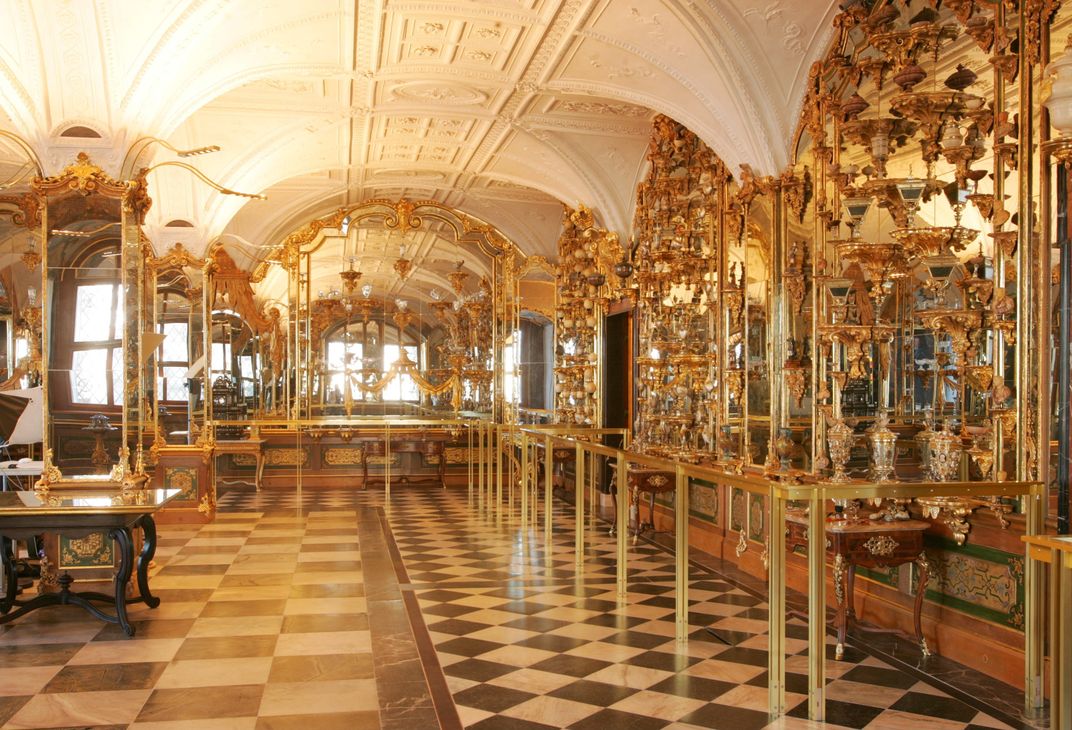Authorities Arrest Three Suspects in $1 Billion Dresden Jewel Heist
Investigators linked the November 2019 burglary to an organized crime syndicate
/https://tf-cmsv2-smithsonianmag-media.s3.amazonaws.com/filer/c6/5f/c65f093a-c303-4ec4-8471-80cd5962e9e9/gettyimages-1184535659.jpg)
Editor's Note, November 17, 2020: German authorities have arrested three suspects linked to the November 25, 2019, Dresden "Green Vault" heist. At least one of the individuals detained was also involved in the 2017 theft of one of the world's largest coins. Both burglaries were likely the work of an organized crime syndicate based in the Berlin borough of Neukölln, reports Philip Oltermann for the Guardian.
The whereabouts of the stolen jewels—valued at “up to a billion euros,” according to local media outlets—are unclear. Authorities are working to recover the artifacts, but they may have already been recut and sold on the black market.
Read more about the 2019 heist—and the Green Vault's storied history—below.
In 1723, Saxony’s ruler, Augustus the Strong, began building an elaborate treasury to house his vast collection of riches. Located in the Dresden Royal Palace, the Grünes Gewölbe, or Green Vault, comprised eight rooms packed with objects made of ivory, amber, silver and gold, as well as portraits of Saxon leaders, vessels adorned with precious stones, and prized natural resources like crystals and ostrich eggs. Today, the Green Vault remains one of Europe’s largest assemblages of treasures. But in the early hours of Monday morning, the treasury-turned-museum became the target of a bold heist.
As Melissa Eddy and Christopher F. Schuetze report for the New York Times, at least two thieves escaped with three of the vault’s 10 jewelry collections just after 5 a.m. local time. The trove of jewels numbers more than 90 individual pieces, including diamonds, sapphires and rubies.
Although local media reported the stolen treasures’ worth as “up to a billion euros,” officials have not yet released an exact estimate. Marion Ackermann, director of Dresden’s State Art Collections, says it is difficult to determine the value of the missing relics because they are “impossible to sell,” according to Kate Connolly of the Guardian.
Ackermann has issued an appeal to the thieves, imploring them not to melt down the jewels or break the collections into smaller sets.
She added, “The material value doesn’t reflect the historic meaning.”

At a press conference held earlier today, Dresden police chief criminal director Volker Lange said two suspects captured on CCTV footage “came in through a window and walked towards a glass vitrine, smashed it and left. [Then] they disappeared.”
Firefighters received word of an electrical fire in the area around the same time police officers were first notified of the burglary. Around 15 minutes after this initial alert, the Times notes, firefighters were called to the scene of a car fire near the museum. Authorities are investigating whether the two incidents are related to the robbery.
Augustus the Strong built the Green Vault—so called for its green malachite columns and green velvet wall coverings—to flaunt the cultural and financial richness of Saxony, a state in eastern Germany. Among the 3,000 or so artifacts housed in its rooms are a fascinating assortment of curios, including Venetian automatons that can pour wine; walnuts carved with tiny faces; and an ornate diorama depicting the riches of Aurangzeb, ruler of India’s Mughal Empire. The most splendid object in the collection is arguably the “Dresden Green Diamond,” a rare and exquisite 41-carat gem currently on loan to the Metropolitan Museum of Art in New York City.
The Royal Palace—including three of the Green Vault’s rooms—was heavily damaged in the Dresden bombings of 1945. Although the vault’s relics were safely hidden in a hilltop fortress during the attack, they were looted by the Red Army at the end of World War II and transported back to the Soviet Union. The treasures were returned to Germany in 1958, but most remained unseen by the public until 2006, when the restored and reconstructed Green Vault finally reopened.
Today, the museum is split into two sections: the Neues Grünes Gewölbe, or “New Green Vault,” where pieces are showcased in “modern minimalist cases,” according to CNN’s Lesley Chow, and the Historisches Grünes Gewölbe, or “Historic Green Vault,” which recreates the sumptuous spaces built by Augustus the Strong.
Roland Wöller, Saxony’s interior minister, told reporters that a special team of investigators is working on the case.
“This is a bitter day for the cultural heritage of Saxony,” he said, as quoted by the Guardian. “The thieves stole cultural treasures of immeasurable worth—that is not only the material worth but also the intangible worth to the state of Saxony, which is impossible to estimate.”